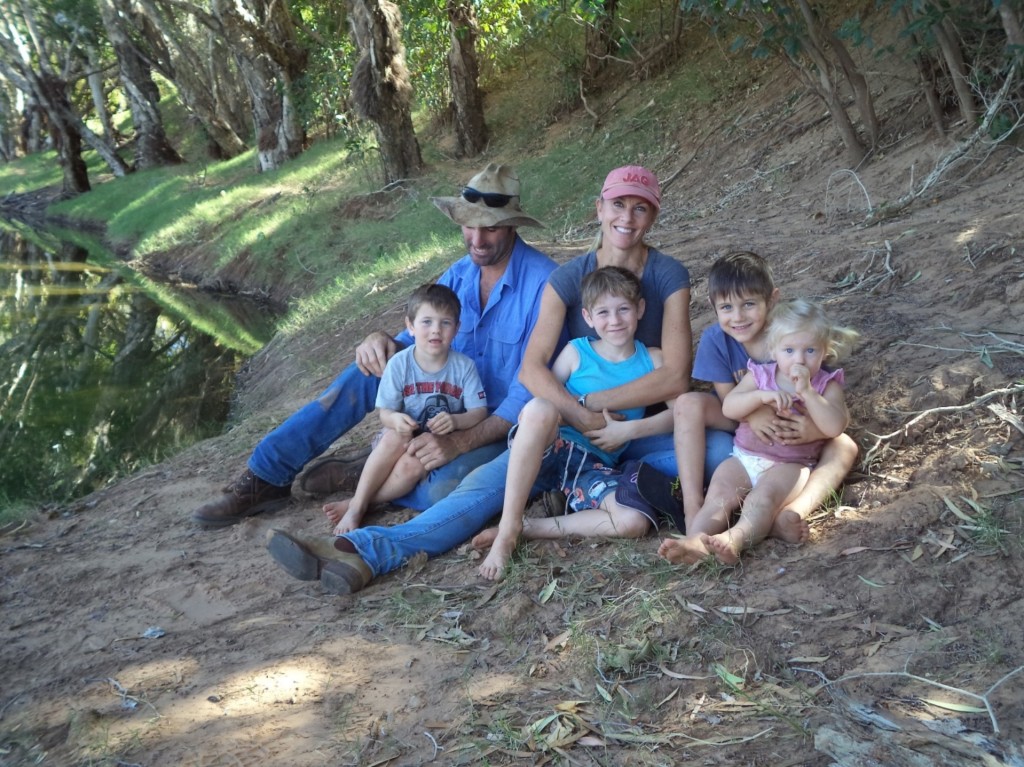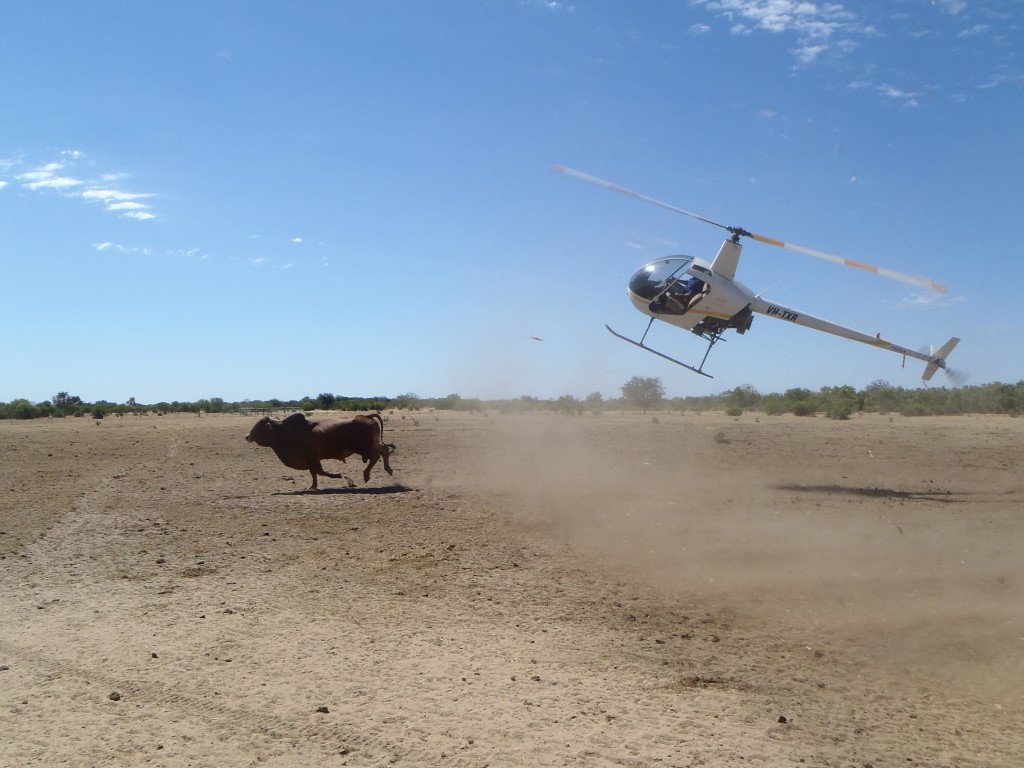Our Kimberley experience so far . . .
Host: Liveringa Station
Written by Peter (Jed) O’Brien – Livestock Manager, Liveringa Station.
Comprising about 265,000 hectares of pastoral cattle lease, Liveringa is situated 120km southeast of Derby; the Fitzroy River forming more than 100km of its southern boundary. We are a large cattle holding with 14,000 breeding cows and 22,000 total head.
While our main focus is beef cattle production, we are a little bit different to most of our neighbours due to the fact that we also have four 90 hectare centre pivot irrigators where we grow fodder for livestock and are experimenting with tropical grain crops.
As host on Central Station this week, I have asked many of those people involved in our cattle operation to assist me by writing a bit about their role(s), experiences and lives here at Liveringa . . .
. . . I begin today with Peter (Jed) O’Brien – my husband and the Livestock Manager of Liveringa.
Karen.
 Karen and Peter (Jed) O’Brien.
Karen and Peter (Jed) O’Brien.
My first year here was pretty flat out. It took a while to find my feet and work out what the role entailed, then longer again to work out how to do it. So it was a little chaotic for that while. It seemed as though, for that year at least, I found myself doing a lot of things twice, finding out the “long” way what works and what doesn’t. I seldom saw our front yard in daylight (at the end of the “dry” I got to see the great job Karen had done with the gardens).
Of course I need to remember (and I am often reminded!) that managing Liveringa is my dream, not Karen’s. After spending nearly twenty years in the north; a few as a young ringer and about eight involved in northern cattle research, I thought I could have a crack at managing a larger cattle station. In January of 2010 we left the comforts of a government job and the great little NT community of Douglas Daly and arrived at Liveringa to the sweltering heat, the driest wet season on record and twice the hours.
While I was busy in the cattle yards, Karen was equally as busy at home, on her own with the three kids. Dealing with school, nappies, the Kimberly heat and dust, isolation etc . . . she once told me that she “could be a single parent anywhere, why on earth would she pick Liveringa Station, remote west Kimberley?” Good point! Any way, we have four kids now so I must have made it home at some point that year (even if it was just for a short while . . . ) Mind you, four kids under seven is enough to keep anyone away from the house!
But these days, after nearly four years, I’m a lot more organised, and less stressed about the all the stuff that still goes pear shaped every day at Liveringa, and the seven or eight kilos that I lost in my first year has managed to relax its way back on.
A day at Liveringa still never ever goes according to plan and with more than 22,000 head of cattle to look after there are always countless things left undone.
So here we are, responsible for those 22,000 head of cattle, each needing to be mustered, drafted, and counted (twice a year if possible), calves weaned and branded, weaners trucked to the station yards, older animals and culls pulled out to be spayed and sale cattle sorted and trucked to market. Most years we will brand about eight or nine thousand young cattle; so far this year we have mustered and drafted more than 26,000 head through the yards and we are just starting a second go round. The sale program is substantial. Every Friday since April, we have trucked three road trains of cattle to market or agistment. So far we have trucked about 3,500 cows and nearly 6,000 weaners, with two or three thousand in waiting.
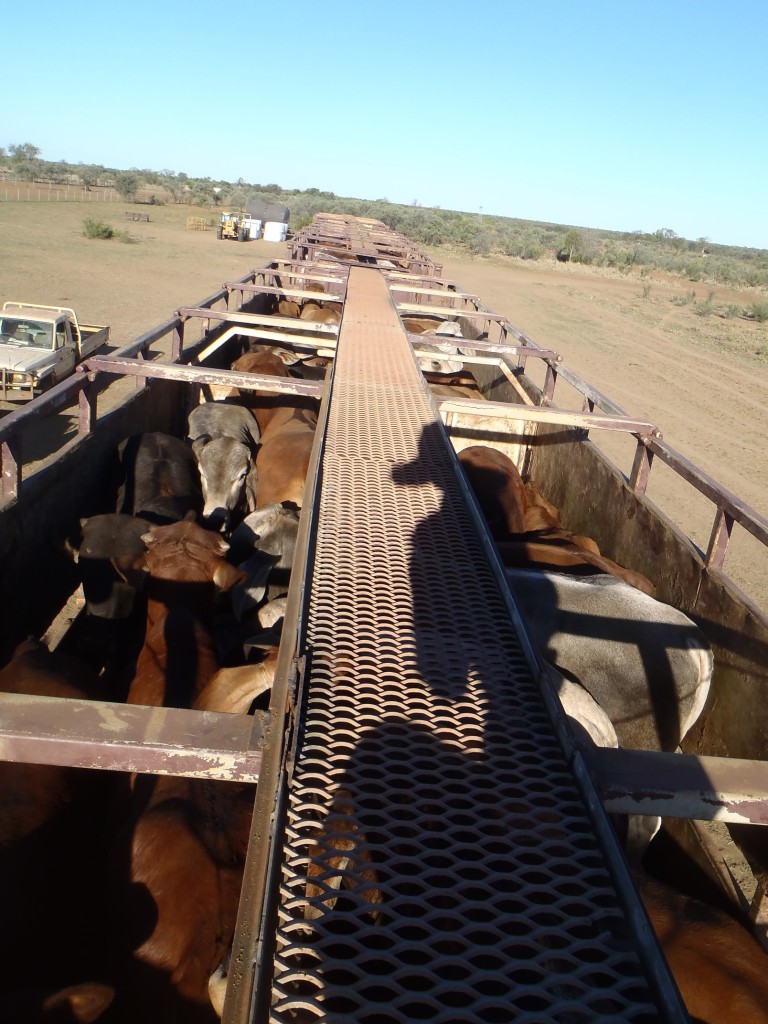 Trucking cattle from outstation back to Inkata yards.
Trucking cattle from outstation back to Inkata yards.
Because we live above the “tick line” nearly all the cattle we sell/truck to the south, need to go through the plunge dip as part of their preparation for trucking. They are checked for ticks, and dipped again before they can be trucked to market. We hold them around the yard on hay for a week during the process. Cattle dipping is a bit of a tourist attraction at Liveringa; if you visit you can’t leave until you watch some cattle go through the bath! Although after dipping more than 10,000 head, twice each, the “tour guides” have become a bit weary of it, and the novelty worn off . . .
 Jumping into the dip .
Jumping into the dip .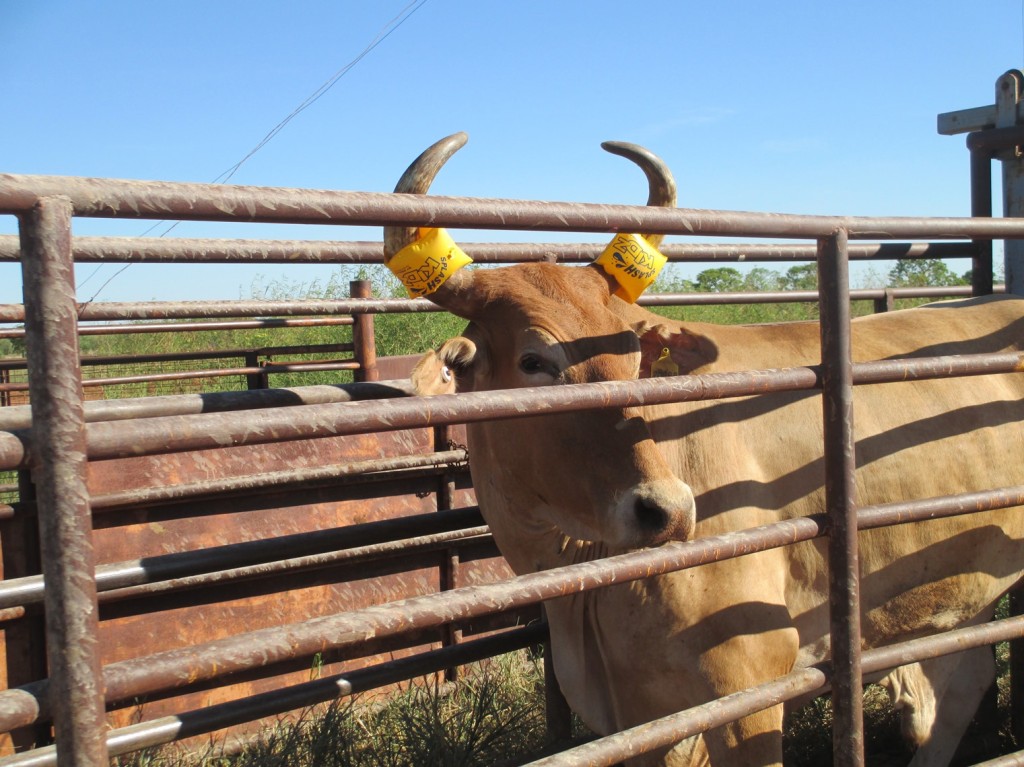 Waiting for his turn in the dip . . . (it’s this guy’s first time!)
Waiting for his turn in the dip . . . (it’s this guy’s first time!)
These cattle need to travel between 2500 and 3600km. It is imperative that they are healthy, well fed, and well rested in preparation for the trip.
There are five sets of cattle yards on Liveringa and we muster surrounding paddocks to each of these yard. Because they are so far away from the main Station (Inkata) the ringers need to “camp out” at these yards until the muster is complete (more about this to follow over the next few days).
We have station horses that the stockcamp ringers ride when working the cattle. We use them a lot during the muster program. Given the sheer size of the breeder paddocks (between 50 and 300 square km) we can do nothing without the helicopter; it is an essential part of our operation and we have a contractor’s machine and pilot based here throughout the dry.
 John Fogharty and his chopper.
John Fogharty and his chopper.
Last week we set out to walk 1200 weaners 35km from an out yard to the Station trucking yard to prepare them for trucking to agistment. The mustering, drafting, and segregating took three days and it’s a two day walk home to the yard. On the night of the first days walk, the weaners took fright, smashed the fence and “went bush” into a 50 square km paddock with 1,100 breeder cows in it . . . leaving 8 ringers, bridles in hand, scratching their heads! So much for next week’s trucking instalment and the program designed around it. These weaners will wait now in that paddock until we do the second muster in it next month and we can start that whole process again. Like I said, things seldom go according to plan and a good sense of humour is the best preparation.
During the dry season every week seems busy; some just more than others. About a month ago, with no notice, we had a contract to supply a shipment with 800 heifers and 1,000 steers. In today’s market, while prices are pretty ordinary, a sale is a sale and every opportunity is taken. The phone call was on Sunday night and the road trains would be here to load Thursday and Friday. “Thursday you reckon, of course we can handle that . . .”
It takes two days and three helicopters to muster the heifers out of Bush paddock and half a day with two machines to muster the steers. So in six days, with little sleep and no time to miss it, we mustered and pre-drafted about 2,500 heifers, then redrafted 1000 of them to secure the sale line. We then walked the remaining 1,700 seven km to their new home, drafted 2,200 steers, trucked 400 and bushed 700 near the yard. We dipped, fed and re-dipped the 650 weaners and sale cows we still had in the yard waiting to go south. Then drafted, weighed and dipped the sale 700 weaners and cows for next Friday’s trucking, pregnancy tested 200 heifers (in the dark) and branded 150 feedlot weaners, just for fun.
We ended up trucking out eight road trains of sale cattle that week plus the obligatory three trains of Friday’s cattle to go south; leaving about 700 head to truck south the following Friday and a further 700 odd in a holding paddock for trucking the week after. So by the end of the week “all the bull shit had become reality” and the contract was filled. And at 4.30pm on Friday when the blunt end of the last truck disappeared, in replica of my own thoughts, Brent, one of our staff, turned to me and asked, “What the hell just happened?” The Rec Club Bar seemed like the logical place for the reply.
The dry season is the time when we get everything done, but the wet is my favourite time of year; it can be a time to slow down a bit. The build up to it is a hot, humid and often unbearable but it is the price we pay for the rain. And when it rains here it rains, the grass becomes green overnight, the cattle are healthy, dams fill and streams rise.
It is generally late in the wet when the Fitzroy River can become a big problem. It has a huge catchment and when the river floods it makes Liveringa look like an inland sea, with water for miles. We have about four days warning before the flood water at Fitzroy Crossing makes its way to Liveringa. We usually carry about 6,000 head of cattle on the river country and it can become a mad rush to get them out of there. Depending on the amount of water coming down, this can mean three helicopters for five days. In the 2011 flood we were only one day ahead of the water as it spent four days spreading across the landscape paddock by paddock. Cattle needed to be moved to higher ground or perish.
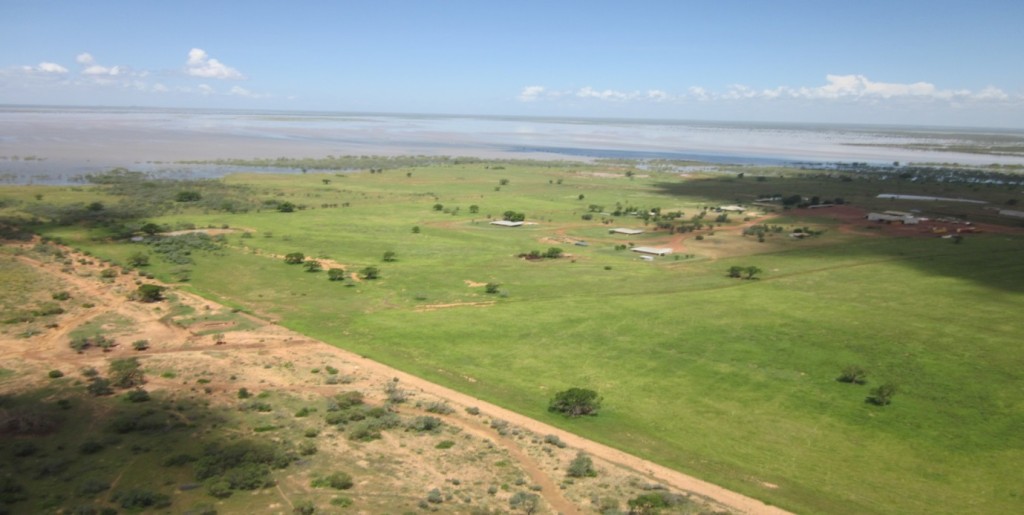 It’s a bit hard to appreciate, but none of the water visible in this photo is normally there!
It’s a bit hard to appreciate, but none of the water visible in this photo is normally there!
 Cattle, stranded on a dam bank, being mustered towards dry land.
Cattle, stranded on a dam bank, being mustered towards dry land.
The river country, by nature of its thick tree growth, creeks and channels, is very hard to muster cleanly at any time of the year. Consequently there are many “feral” bulls and cows (two to ten year old “cleanskins” or unbranded bulls and cows of questionable genetic composition) along the river system. While constantly trying to improve the breeding of our cattle herd it is important that these undesirable cattle are mustered and sent to market. They are reluctant to relocate; wily and cunning. They can hide under vegetation and ignore or run underneath the chopper or simply stand defiant.
Flying over the flooded river you might see a cohort of these defiant ferals “suffering in their jocks” as they stand on a small piece of high ground, belly deep in the rising floodwater. They will need to stand there for six or seven days or more.
I have heard it said that if an animal stands in water for a week their hooves will fall off! Well they must grow back too, because I’m sure these same mongrel cattle were still trying to outrun the helicopters again this year!
During our dry season breeder muster of 2011 we mustered about 100 Jubilee station steers. Jubilee is a station near Fitzroy Crossing, 150km away. These cattle had been caught up in the flood water and washed down the river; they got out at Liveringa. The same goes for the eighty odd spayed heifers from Kalyeeda Station, 120km to our south east. (We probably only ate 3 or 4 of these animals . . . the rest were returned on our road train later in the year!)
It’s worth mentioning that in the late 1800’s and for most of the 1900’s Liveringa was a sheep station, running more than 100,000 at its peak. I expect more than a few of these poor woolly buggers found their way down the river and met their fate somewhere out into the King Sound or Indian ocean. No BOM site or Radar in the 1920’s . . .
Another part of my job that I really enjoy is working with and teaching the younger members of staff; the ringers and jillaroos. They keep me entertained to some extent with their antics, and often “out there” conversations. They also help to keep me fit as I try to out run or just keep up with their level of vitality. I think it’s important that you let the staff enjoy their work; I reckon you get more out of them that way. I try to make sure (ad nauseum I’m sure) that they go home having learned something. I’m au fait with all the mod cons now – I know all about iPods and iPhones, snap chats, face time and book face. These guys help me to recognise what’s cool and hip and what’s not. Usually they are, and I’m not . . .
Karen and I are both gregarious people, and while we live a long way away from our immediate families and old friends, for the most part, we have both been enjoying the job and the lifestyle in the isolation of the West Kimberley. We both appreciate the space, the landscape and the nature. I love working with cattle and always try to do the right thing by them. And although it doesn’t happen often these days, we both enjoy a chance to get out on the horses.
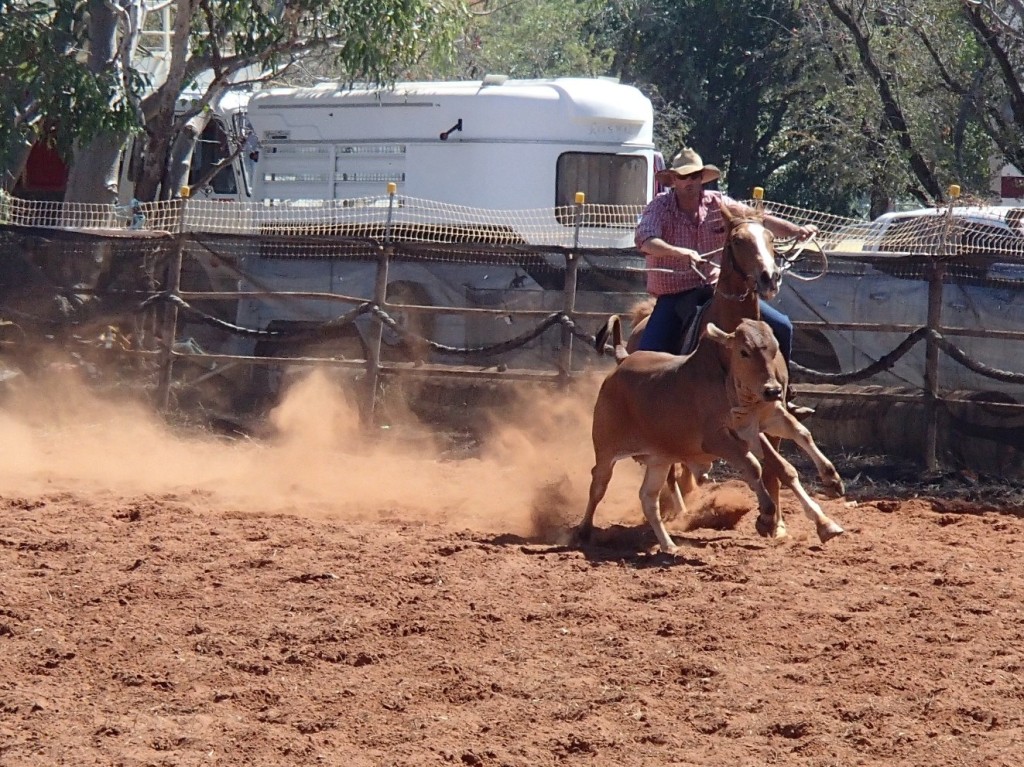
Maintaining a happy and harmonious life on the Station depends a lot on the people we are surrounded by; live and work with. This year we seem to have the mix pretty close to right, with a good blend of old and young (at only 43, I’m still not real sure which category I’m in).
Some people work a nine to five, drag job that they don’t really enjoy, but it pays the bills. I think for most people in our industry the opposite is true, we enjoy the job, but it sometimes barely pays the bills. I reckon I’m one of the lucky ones, I have been in the livestock industry for my whole life and I can’t remember having a bad day at work. In a lot of ways my work is my hobby. I can’t imagine working in another industry. And as for the next four years at Liveringa, well it’s like they say, “happy wife happy life”. I guess I will be wandering around the cattle yards at Liveringa, “living the dream” as long as Karen and the kids are still happy with the deal . . .

